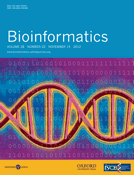
PROTEINS-STRUCTURE FUNCTION AND BIOINFORMATICS
Scope & Guideline
Advancing Knowledge in Biochemistry and Beyond
Introduction
Aims and Scopes
- Protein Structure Analysis:
The journal emphasizes the structural characterization of proteins using techniques like X-ray crystallography, NMR spectroscopy, and cryo-EM, contributing to our understanding of protein function and interactions. - Computational Modeling and Simulation:
A significant focus on computational approaches, including molecular dynamics simulations, machine learning, and bioinformatics methods, to predict protein structures, dynamics, and interactions. - Protein-Protein and Protein-Ligand Interactions:
Research often investigates the mechanisms of protein-protein and protein-ligand interactions, including binding affinity predictions and modeling complex formations. - Post-Translational Modifications:
The journal covers studies on the effects of post-translational modifications on protein function, stability, and interactions, highlighting their biological significance. - Thermodynamics and Stability:
Research addresses the thermodynamic principles underlying protein stability and folding, often using computational methods to explore stability-enhancing mutations. - Bioinformatics Tools and Resources:
The journal contributes to the development and application of bioinformatics tools for protein analysis, structure prediction, and functional annotation.
Trending and Emerging
- Machine Learning and AI in Protein Research:
There is a notable increase in the application of machine learning and AI techniques for predicting protein structures, interactions, and functions, showcasing their potential to revolutionize protein science. - Integration of Structural Biology with Genomics:
Emerging themes focus on integrating structural biology with genomic data to enhance our understanding of protein functions within broader biological contexts. - Dynamic and Flexible Protein Structures:
Research on the dynamics and flexibility of proteins, including studies on intrinsically disordered regions, is gaining traction, emphasizing the importance of dynamic behavior in protein function. - Thermostability and Engineering of Proteins:
There is a growing interest in enhancing protein thermostability through engineering, particularly in the context of biotechnological applications. - Drug Discovery and Protein Targeting:
Research related to drug discovery, particularly using structural insights for targeting proteins in disease contexts, is increasingly prevalent, reflecting a focus on therapeutic applications.
Declining or Waning
- Classical Protein Structure Prediction:
Traditional methods of protein structure prediction based solely on sequence homology have become less prominent, as newer, more accurate approaches like AlphaFold have gained traction. - Single-Method Experimental Approaches:
Research relying solely on single experimental techniques, such as only X-ray crystallography or NMR without computational support, is waning, as integration with computational methods becomes the norm. - Niche Proteins and Rare Pathways:
Studies focusing on niche proteins or rare biological pathways have seen less attention, likely due to a broader interest in more universally applicable proteins and pathways.
Similar Journals

BIOINFORMATICS
Leading the Charge in Bioinformatics DiscoveriesBIOINFORMATICS, published by Oxford University Press, is a leading journal in the realms of biochemistry, computational mathematics, and computer science, with a notable impact factor that underscores its significance in the field. Since its inception in 1985 and continuing through its expected convergence in 2024, the journal has maintained a prestigious reputation, proudly residing in the Q1 category across multiple disciplines, including molecular biology and statistics. With a Scopus ranking placing it within the top percentiles of its categories, BIOINFORMATICS serves as an essential platform for disseminating high-quality research that advances knowledge and innovation at the intersection of biology and computational sciences. This journal not only offers both subscription and open access options, ensuring wider availability of its cutting-edge research, but it has also become a crucial resource for researchers, professionals, and students aiming to stay at the forefront of bioinformatics and related fields. Explore the latest findings and trends that define the future of biological research through this esteemed publication, any inquiries regarding the journal can be directed to its offices located at Great Clarendon St, Oxford OX2 6DP, England.

Journal of Structural Biology-X
Illuminating the Complexities of Molecular ArchitectureThe Journal of Structural Biology-X, published by Elsevier, is a leading open-access journal dedicated to advancing the field of structural biology. Launched in 2019, it has quickly established itself as a vital resource for researchers, professionals, and students, boasting a prestigious Q1 ranking in Structural Biology for 2023 and achieving an impressive Scopus rank of #19 out of 49 in the biochemistry, genetics, and molecular biology category. With an E-ISSN of 2590-1524, this journal emphasizes accessibility and collaboration by providing open access to its comprehensive collection of research articles, reviews, and cutting-edge methodologies. The scope of the journal encompasses significant themes within structural biology, including protein structure, molecular interactions, and imaging techniques, facilitating interdisciplinary dialogue and innovation. Join the global community of scientists and contribute to the body of knowledge that propels our understanding of molecular architecture through the Journal of Structural Biology-X.

CRITICAL REVIEWS IN BIOCHEMISTRY AND MOLECULAR BIOLOGY
Charting New Pathways in Biochemical SciencesWelcome to Critical Reviews in Biochemistry and Molecular Biology, a premier academic journal published by Taylor & Francis Ltd, dedicated to advancing the fields of biochemistry and molecular biology. With an impressive impact factor and a Q1 ranking in both Biochemistry and Molecular Biology for 2023, this journal serves as a vital resource for researchers, professionals, and students eager to engage with cutting-edge reviews and analyses that synthesize the latest developments in these dynamic areas of study. Since its inception in 1972, the journal has maintained a commitment to high-quality scholarship, providing a platform for critical discussions that accelerate the discovery and understanding of biochemical processes and molecular interactions. Although not open access, its robust editorial peer-review process ensures that published articles meet the highest standards of scientific rigor, making it a trusted source for the scientific community. As we continue to converge toward 2024, we invite you to explore the extensive array of topics and findings that have shaped contemporary biochemistry and molecular biology.

BIOCHIMICA ET BIOPHYSICA ACTA-PROTEINS AND PROTEOMICS
Transforming Insights into Proteomic DiscoveriesBIOCHIMICA ET BIOPHYSICA ACTA-PROTEINS AND PROTEOMICS, published by Elsevier, is a prestigious academic journal that serves as a vital resource for researchers, professionals, and students in the fields of biochemistry, biophysics, and proteomics. With an ISSN of 1570-9639 and an E-ISSN of 1878-1454, this journal features high-impact research articles aimed at advancing our understanding of protein structure, function, and interactions, contributing significantly to both theoretical and applied sciences. Recognized for its quality, it proudly holds a Q1 ranking in Analytical Chemistry and Biophysics, and Q2 in Biochemistry for 2023, alongside notable Scopus rankings that reflect its influence in the realm of molecular biology. The journal's commitment to disseminating essential findings supports the ongoing evolution of proteomic sciences and encourages collaborative discourse among the global scientific community. For aspiring authors, the journal offers open access options, enabling broad visibility of their work. Join the conversation in this dynamic field and contribute to shaping the future of protein research!

FEBS LETTERS
Pioneering New Ideas in Biochemistry and GeneticsFEBS LETTERS, published by Wiley, is a prestigious journal that has firmly established its place in the fields of biochemistry, biophysics, genetics, molecular biology, cell biology, and structural biology. With an esteemed history dating back to 1968, this journal continues to be a vital resource for researchers and professionals involved in the biological sciences. It boasts impressive quartile rankings, including Q1 statuses in several categories such as Biochemistry and Genetics, reflecting its high impact factor and significant contribution to scientific discourse. FEBS LETTERS provides a platform for innovative findings and critical reviews, fostering the exchange of knowledge and ideas within the scientific community. Although it operates under a subscription model, the journal ensures broad dissemination of groundbreaking research through its rigorous peer-review process. The vibrant discussions encouraged by articles published in FEBS LETTERS aim to inspire current and future generations of scientists to push the boundaries of biological understanding, making it an indispensable resource for anyone dedicated to advancing their knowledge in these dynamic fields.

JOURNAL OF BIOLOGICAL CHEMISTRY
Shaping the Future of Biological SciencesJOURNAL OF BIOLOGICAL CHEMISTRY, published by Elsevier, is a premier interdisciplinary journal dedicated to advancing our understanding of biochemistry, cell biology, and molecular biology. With a prestigious history dating back to 1945 and an impressive convergence of research expected to continue through 2024, this journal holds a Q1 ranking in all three of its core categories, signaling its critical influence in the respective fields, supported by a robust Scopus ranking that places it among the top echelons of internationally recognized research. Although currently not available as Open Access, the journal is essential for researchers and professionals looking to stay abreast of the latest breakthroughs and innovations in biochemical research. With a deep commitment to scientific rigor and a focus on diverse topics ranging from cellular processes to molecular mechanisms, the Journal of Biological Chemistry serves as a vital resource for the academic community, shaping the future of biological sciences.

Molecular Cell
Exploring the Nexus of Molecular and Cellular Biology.Molecular Cell, published by Cell Press, is a leading journal in the fields of cell biology and molecular biology. Established in 1997, this prestigious journal boasts a significant impact within the scientific community, evidenced by its impressive 2023 Scopus rankings, placing it in the top 2% of its field (Rank #10/410 in Molecular Biology, Rank #12/285 in Cell Biology). With a focus on cutting-edge research that bridges the gap between molecular genetics and cellular function, Molecular Cell serves as an essential platform for the dissemination of vital findings and innovative methodologies. Although it follows a traditional publishing model without Open Access options, its rigorous peer-review process and high standards ensure that articles published within these pages are of the utmost quality, making it an invaluable resource for researchers, professionals, and students alike seeking to stay at the forefront of scientific discovery. The journal's address is 50 Hampshire St, Floor 5, Cambridge, MA 02139, United States, reinforcing its commitment to fostering scientific excellence and collaboration.

JOURNAL OF MOLECULAR BIOLOGY
Advancing the Frontiers of Molecular DiscoveryThe Journal of Molecular Biology (ISSN: 0022-2836, E-ISSN: 1089-8638), published by Academic Press Ltd - Elsevier Science Ltd, stands as a premier platform for disseminating significant advancements in the field of molecular biology. With a distinguished history of publication spanning from 1959 to 2024, this journal is recognized for its high-quality, peer-reviewed articles that engage with transformative research in biophysics, structural biology, and molecular biology. The journal holds an impressive Q1 category ranking across these disciplines in 2023, affirming its impact and relevance within the scientific community. Notably, it ranks #11 in biophysics and #5 in structural biology based on Scopus metrics, placing it in the 93rd and 90th percentiles, respectively. As an essential resource for researchers, professionals, and students alike, the Journal of Molecular Biology serves as a vital conduit for the exchange of innovative ideas and discoveries, fostering a deeper understanding of life's molecular underpinnings.

PROTEIN SCIENCE
Exploring the Vital Role of Proteins in Health and DiseasePROTEIN SCIENCE, published by Wiley, is a premier journal dedicated to the field of biochemistry, molecular biology, and medicine, boasting an impressive impact factor that reflects its influence and importance within the academic community. Established in 1992, the journal has continuously provided a platform for high-quality research, with a current classification in the top quartile (Q1) for its critical contributions to the understanding of protein structure and function, as well as its applications in health and disease. With a Scopus ranking placing it in the 91st percentile among its peers, PROTEIN SCIENCE publishes cutting-edge studies and reviews that are essential for researchers, professionals, and students seeking to advance their knowledge in protein research. Although it does not currently offer open access options, the journal remains dedicated to disseminating vital findings that support the ongoing advancements in molecular biology and biochemistry. Researchers can count on PROTEIN SCIENCE for consistently rigorous peer-reviewed content that fosters meaningful dialog and innovation in the life sciences.

MOLECULAR BIOLOGY
Connecting Researchers to the Heart of Molecular BiologyMOLECULAR BIOLOGY, published by PLEIADES PUBLISHING INC, serves as a vital repository for the dissemination of innovative research within the fields of biochemistry, genetics, and molecular biology. With an ISSN of 0026-8933 and an E-ISSN of 1608-3245, this journal has been a mainstay in the scientific community since its inception, embracing its deep historical roots from 1971 to the present. Recognized for its qualitative contributions, MOLECULAR BIOLOGY is ranked in the Q3 quartile for Biophysics and Q4 for Structural Biology, placing it among select journals in its domain. Researchers and students alike benefit from its rigorous peer-reviewed articles, which focus on all aspects of molecular mechanisms and interactions. The journal's inclusion in prestigious databases underlines its commitment to academic excellence. The editorial board is dedicated to fostering the sharing of influential findings, making it an essential resource for advancing knowledge and innovation in molecular biology.